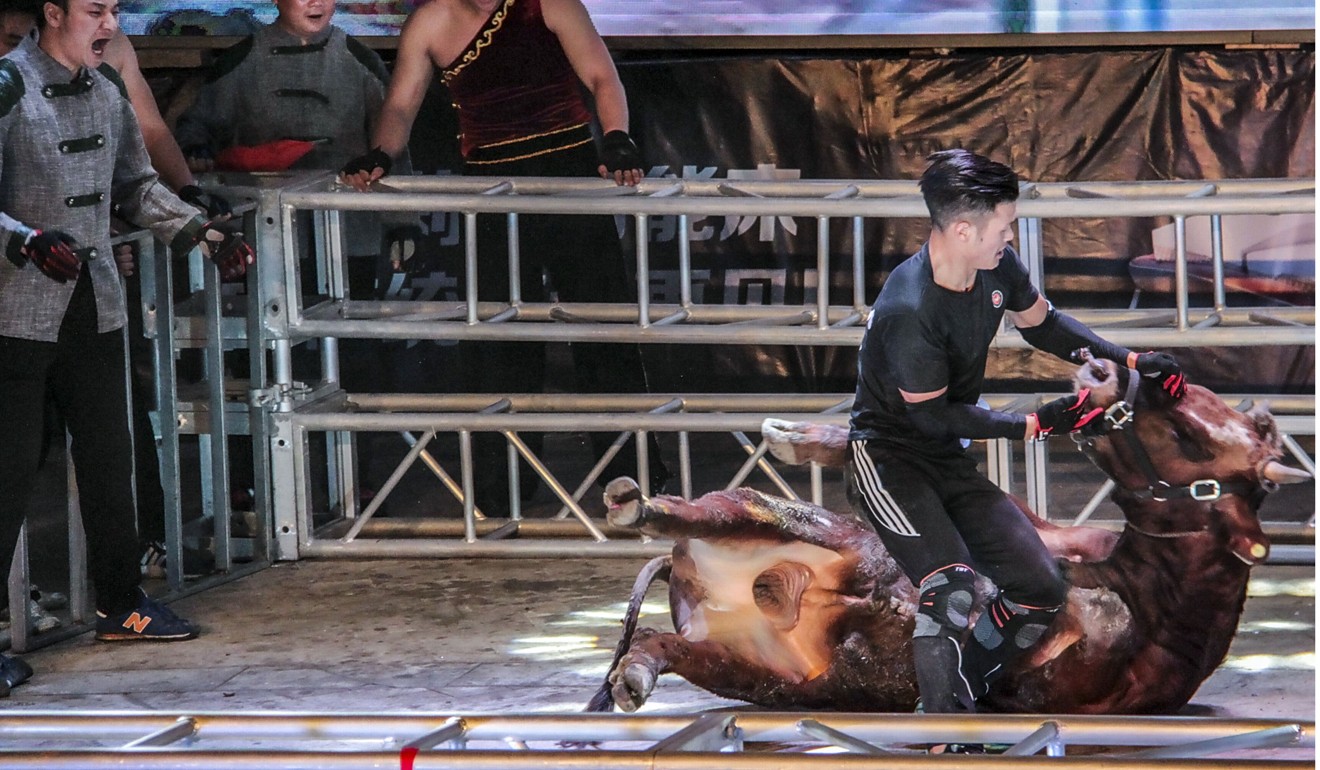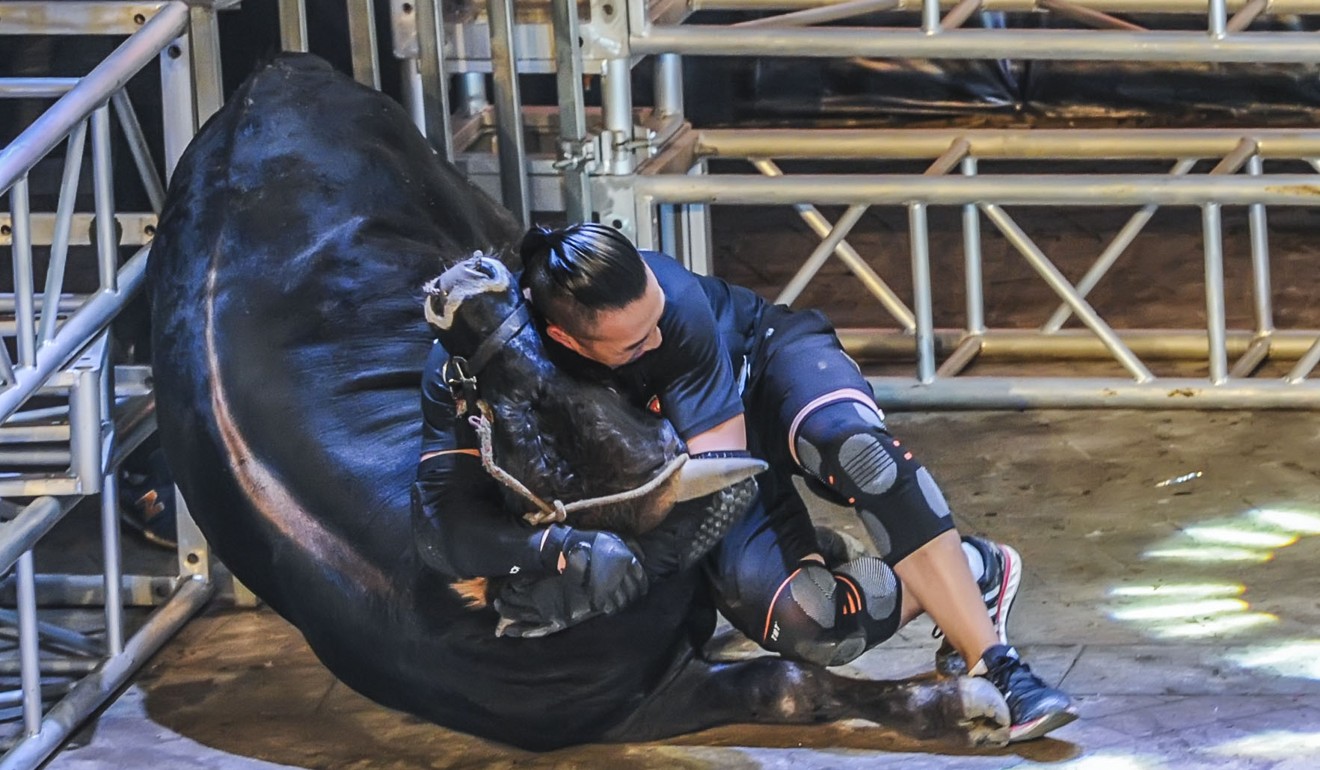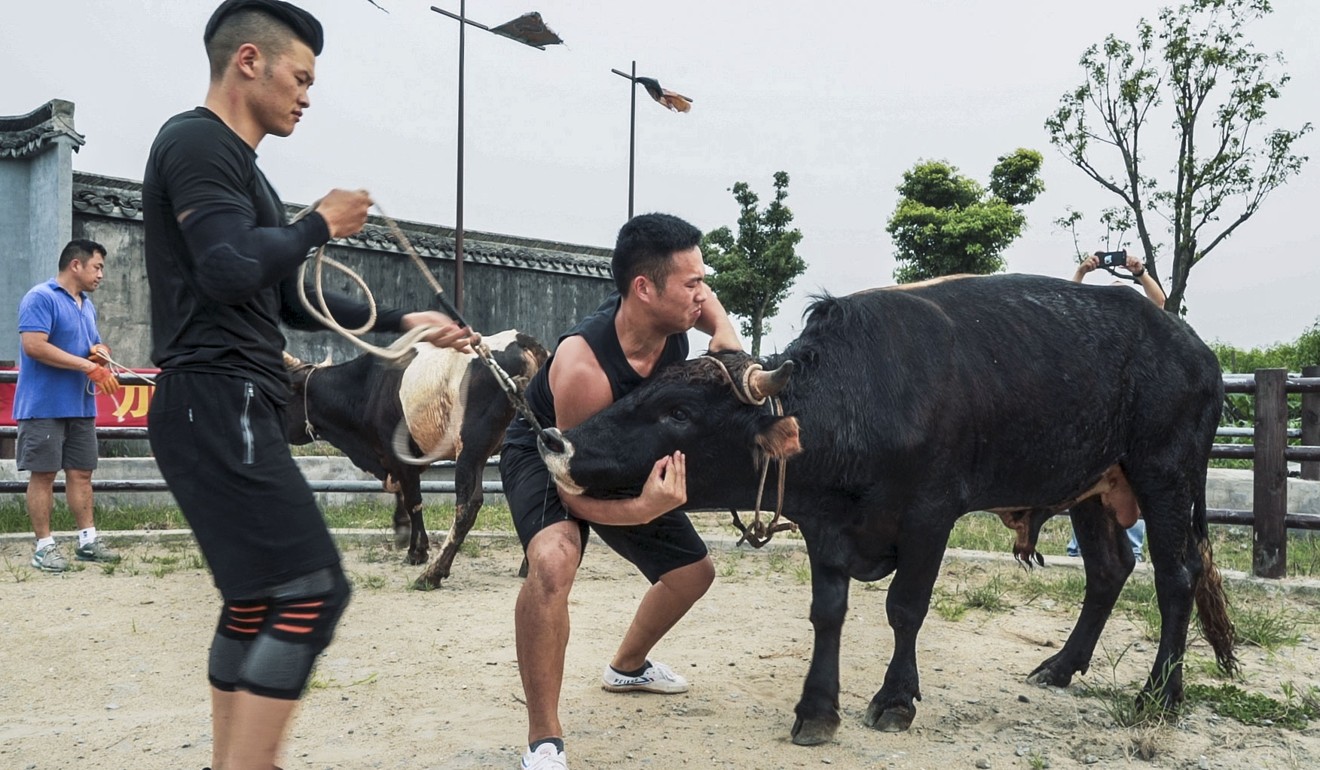
China’s kung fu bullfighters dismiss cruelty claims as ancient martial art booms
Despite concerns from animal rights activists, practitioners of the centuries-old form of animal wrestling are keen to showcase their skills
The first time Li Bo stood eye to eye in the ring with a 450kg (990lb) bull, he was afraid. He understood well that with its massive power and sharp horns, the bull could gore or kill him in moments.
But as the kung fu practitioner’s training in ancient Chinese bullfighting continued in Jiaxing, in the eastern province of Zhejiang, he learned to use his martial arts experience to turn his adversary’s strength against it.
And one day the breakthrough came.
“I figured out techniques to use the force of my strength to make it fall to the ground, to put it in a headlock,” Li, 22, said. “And [I] felt like I was accomplishing something really meaningful.”
Li is one reason that Chinese bull-wrestling – a discipline dating back centuries to the era of the Hui Muslims – is becoming increasingly prominent in China.
As practised in Jiaxing, the cradle of the pastime, it differs from better-known Spanish bullfighting in one major respect: the bull is not killed at the end.
For this reason, its practitioners claim the Chinese version is more humane.
The spectacle is boosting the economies of rural villages in the area, drawing tourists and prizes with ever-greater purses.
Watching a video of Li in the ring is to see a display of self-discipline and martial arts intelligence pitched against a finely tuned force of nature.
Li’s heavy grunts rise about the cheers of the crowd as he goes up against the massive animal, with its muscular neck and large, bony head.
Then a sweat-soaked Li grabs the bull by its lethal horns. Calling on all his training and experience, the fighter engages the massive beast in a struggle. After long moments of grappling, Li topples the overwhelmed creature to the ground, triumphant.
Red flag for Buddhists? Shaolin Temple ‘takes the lead’ in Chinese patriotism push
For Li, devoting himself to bull-wrestling three years ago was “the natural conclusion” of his kung fu training.
But his parents dismissed his bullfighting ambitions as madness.
“When I first started bullfighting, my parents didn’t understand why,” Li said. “They thought it was a very dangerous sport and were worried that I would be gored, crushed or thrown to the ground by the bull.”
But their opinion slowly changed after Li sent them videos of himself in the ring, he said.

Li follows in the steps of kung fu master Han Haihua. In 2008, Han was the first to formalise the sport by setting up the Haihua Kung Fu Club, China’s only martial arts association dedicated to training the next generation of professional bull wrestlers.
Han, a Hui Muslim, made his name as China’s first nationally recognised bullfighter during the 1982 National Ethnic Minority Games, in which he tackled a giant bull to the ground.
“During the annual festival of Eid, Hui Muslims will normally sacrifice cattle and out of this, people started to wrestle with the bulls,” Han, 65, said. “So bull-fighting developed out of a combination of Hui culture and Chinese martial arts culture.”
Han agrees that Chinese bullfighting is humane, compared with its famous Spanish counterpart.
Turning Shaolin monks into entertainers: Shanghai wrestlers tell the world about Chinese martial arts in the ring
“We make the bulls fall over in a way that doesn’t injure their bodies or cause bloodshed,” Han said, adding that the rules prohibit fighters from shouting at the bulls.
But bullfighting styles vary within China as well as between nations.
In the southwestern provinces of Yunnan and Guizhou, for example, two bulls are made to fight each other, instead of humans.
To be a successful bullfighter, practitioners must have a good grasp of martial arts skills and “hard qigong” – a technique of concentrating one’s entire strength through breath control and body movements, according to Han. Hard qigong is the technique that allows kung fu fighters to smash bricks with their bare hands.
“A bull’s hide is quite thick and their body is large, so if they push you or gore you, can you stand it?” Han asked. “Of course not. You need to practise hard qigong to develop this kind of wrestling technique.”

Although locals defend the sport as part of Jiaxing’s intangible cultural heritage, it has triggered criticism from animal rights advocates.
Peter Li, a professor at the University of Houston-Downtown and a China policy specialist for Humane Society International, calls bull-wrestling an unacceptable form of entertainment in modern-day China.
“Culture or tradition is no defence or justification for animal cruelty of all manifestations,” Li said.
“Bull-wrestling serves to desensitise the audience, particularly young people, to animal cruelty.”
Enter The Dragon remake? Bruce Lee must be spinning in his grave – leave the kung fu icon’s martial arts masterpiece alone
He added that, despite the trainers’ claims that they treated the bulls well, “the fact that ‘training’ bulls have to wrestle as a daily routine for the entertainment of humans is cruel since the bulls are forced to act unnaturally or against the nature of bulls”.
As such, the bulls were “denied the ability to display their natural behaviour”, which could cause them physical and psychological damage.
Moreover, the activity, along with all forms of animal cruelty in the name of culture and tradition, “tarnishes the reputation of Jiaxing, Zhejiang and China” on the international stage, the professor argued.

Li Bo said he was aware that many people viewed the sport as cruel to animals, but countered that those who did just did not understand it deeply enough.
“Our bulls are not like normal bulls, they are specially trained fighting bulls,” he said. “It’s like the difference between an ordinary human who’s not very fit, and a trained boxer. Their body strength and fighting capabilities are completely different.”
Although the bulls may be opponents in the ring, the bullfighters say their relationship with the creatures is much friendlier outside training hours.
The dogs fighting wild boars in illegal pits in Indonesia, and the activist trying to put a stop to it
“When we have free time, we groom their fur, bathe them, take them out for grazing and feed them,” Li said. “While other people look after dogs and cats, we see the bulls as our pets – I believe they are even more loyal than dogs.”
While some bulls are naturally more fiery than others, the club prides itself on not using chemical stimulants on the animals to manipulate their performance, as some Spanish bullfighters have been accused of doing.
“We grab hold of its horns and slowly let its fierceness develop, and from this we can have a more equal match between human and bull,” he said.

Han’s Haihua Kung Fu Club is partly government funded. Han said the lack of funding and investment was an impediment to developing the sport and allowing it to attain the same level of international exposure as other martial arts, such as judo, taekwondo and Muay Thai.
To ease the financial burden of raising and training bulls, the club has held annual bull-fighting tournaments over the past seven years, inviting outsiders to compete before hundreds of spectators.
Han said he was looking at other ways to earn revenue from the sport and potentially bring it to a larger audience internationally to ensure its survival.
For Li, however, going up against the bulls continues his devotion to his lifelong love: martial arts.
“Whenever I saw it on TV as a child, I would feel really excited, and this feeling is partly why I started kung fu training,” Li said.
“I think that, maybe, every man secretly wishes he could become a martial arts hero.”

